The Helga and the shelling of Liberty hall
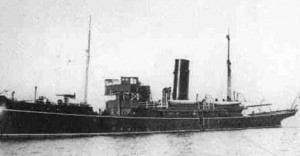
By Michael Barry. In researching my book ‘Courage Boys, We are Winning, an Illustrated History of the 1916 Rising’, I came across much interesting new detail. This is one of a series of articles I have written where I identify new facts relating to various events of the Rising, and hopefully, dispel a few myths.
On the morning of Wednesday, 26th April, ‘HMY Helga’ sailed up the Liffey and anchored by the Loop Line Bridge near Custom House Quay. The ‘Helga’, a fishery protection vessel, built in Dublin in 1908[1], had been used as an anti-submarine patrol vessel after the outbreak of WWI.
The Helga fired 24 shells at Liberty Hall.
The log of the ‘Helga’ is rather succinct: “26 April. Proceeded up River. Stopped near Custom House. Opened fire on ‘Liberty Hall’ in conjunction with Military. Fired 24 rounds (8.00 am).”[2] Within those few words, lies the enigma of what actually ensued. This article attempts to ascertain some facts surrounding the bombardment of Liberty Hall.
The ‘Helga’ anchored in front of the Custom House. In a coordinated mission with the British Army, the intention was to bombard Liberty Hall. It is reported that a Guinness ship was moored by the Custom House.[3]
Unbeknownst to the British, Liberty Hall (headquarters of the ITGWU and the Irish Citizen Army), was by now abandoned. One problem for the assault was the intervening Loop Line Bridge, an example of substantial and heavy Victorian railway engineering.
The ‘Helga’ fired 24 rounds from its 12-pounder deck gun. These were high-explosive shells, i.e. which explode on impact. One account tells that the first shell hit the bridge.
At the same time, British Army gunners had moved an 18-pounder field gun from Trinity College. They set up by the south quays by Butt Bridge at Tara Street, and proceeded to shell Liberty Hall as well. They had only shrapnel shells. These did not contain high explosive and would have the effect of a glorified but high-velocity cannon-ball.

Looking at a section of Liberty Hall, the Loop Line Bridge and the ‘Helga’ (Figure 1) – the Helga was very constrained in its field of fire in the vertical sense, by the soffit of the Loop Line Bridge and the top of the quay walls. The tide level pertaining at 08.00 on Wed 26th April was obtained courtesy of the Marine Institute. The section is generally to scale.
The ship’s line of fire was very constrained.
Looking at a plan of the Liffey, and the area around the Custom House and Liberty Hall, with the ‘Helga’ shown at a possible location (Figure 2) – as seen, the ‘Helga’ was very constrained in its field of fire in the horizontal plane. This was by the northern piers of the Loop Line Bridge, as well as the buttress on Custom House Quay. If there was indeed a Guinness ship moored by the Custom House, the ‘Helga’ would have had to anchor at a distance to avoid causing it any damage.
However, from the plan, it is evident that the ‘Helga’ could manoeuvre to reach the front of Liberty Hall with its shells, as well as reach the adjacent Northumberland House. This is all in the context of the constraints in the vertical sense of the bridge soffit and in the horizontal sense of the pier and abutments – the Helga’s gunners did not have an easy task!
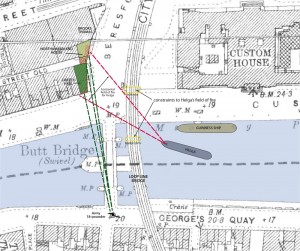
Analysis of the Damage
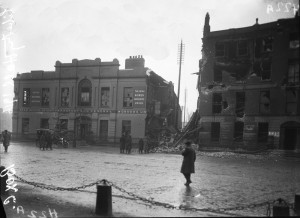
Attached are two views of the damage to Liberty Hall after the Rising, viewed from the south (Figure 3), as well as from the south-west (Figure 4). Also attached is an image of damage within (Figure 5).
Analysis of the damage shows that the combined naval and army artillery assault did not inflict much damage to the front of Liberty Hall. Liberty Hall was damaged internally, but was not burnt out and in rubble like the buildings around Sackville Street. By contrast, the adjacent Northumberland House was severely damaged, particularly the section over the intervening laneway (which is completely destroyed).
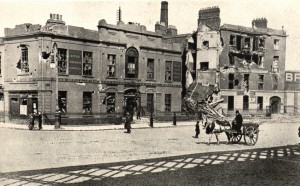
The lower point must have received heavy fire from the ‘Helga’, as the Army 18-pounder could not reach this low point. From the plan (Fig 2), it is obvious that the Army 18-pounder could only hit the front face of Liberty Hall a glancing blow.
The Army gun could, however, reach the top of the (south facing) gable of Northumberland House, above the line of the Liberty Hall roof. It is likely that the significant damage to the end of Northumberland House was contributed to by the Army 18-pounder.
The relatively small damage to the south gable of Liberty Hall seems to be due to the shrapnel shells fired from the Army 18-pounder across the river at Tara Street. The gable end would have been principally in the Army gunner’s sights. The damage consists of both pockmarks and relatively small holes.
Liberty Hall was damaged but not, as is often maintained, destroyed by the shelling.
Not much damage was caused to Liberty Hall. It did not catch fire. As evidenced by interior photos taken after the Rising (as seen in Figure 5), some rooms were damaged (possibly by Helga’s high explosive shells coming through a window and then exploding), others not.
It appears that the Helga’s guns could reach the front of Liberty Hall. Why are there only relatively minor shell pockmarks on the front of the building? Some shells are likely to have gone in through the windows, as evidenced by the large number of broken panes. The adjacent Northumberland House suffered significant damage.
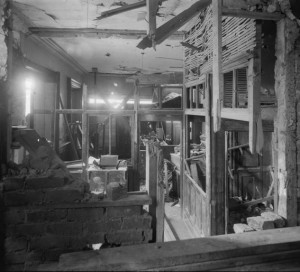
This amounted to total destruction of the section over the lane, large shell holes and damage in the southern side of the building. It must have received a significant pounding by the Helga’s high explosive shells (as well as the previously mentioned shell fire at high level from the Army 18-pounder). A contributing factor may have been that Liberty Hall (previously a hotel) was perhaps of more substance and the walls more solidly built than the brick of Northumberland House.
However, the concentration on Northumberland House is puzzling: Liberty Hall certainly did not hide its light under a bushel: the name ‘Irish Transport & General Workers Union’ was displayed on the façade. The Helga’s captain may have had bad (but more likely no) useful intelligence on the Rebels and their redoubts. Perhaps they were under the misapprehension that what they perceived as the ‘rebel’ HQ also encompassed the adjacent building.
Another question is: did the Helga sail downriver and attempt to shell Liberty Hall by lobbing shells at it parabolically? It is possible, but it would have been very difficult to do this and avoid damage to the Loop Line Bridge and possibly the Guinness ship and the Custom House, as well as other buildings in the area.
Max Caulfield in his entertaining (but not always accurate) ‘The Easter Rebellion’ wrote that, after an ineffectual attempt to hit Liberty Hall, it tried to lob a shot over the bridge. “..Finally, a second shot was fired. This time the result was better and the crew raised a resounding cheer; the shell landed squarely on top of Liberty Hall, wrecking the interior but leaving the outer walls intact.”[4] There may be an element of truth in this, but there were a large amount of shells which hit the building full on, which not consistent with a ‘lobbing’ shot, more a direct one under the bridge.
Contrary to popular myth, the fire of the Helga was mainly ineffectual.
If the Helga did lob more shell parabolically, there might have been a few strays sent in the direction of Sackville Street. However, there is no evidence that there was deliberate shelling of the Sackville Street area by the ‘Helga’ (the British Army began shelling Sackville Street using 18-pounders the following day, Thursday).
A shell landed in the grounds of the Viceregal Lodge[5]. Did it come from the ‘Helga’? Another account says that is was due to the army shelling of positions in Sackville Street- that a gunner was trying to hit a sniper on a roof and the shell sailed onwards to the Phoenix Park.
Another story, much promulgated, is that the Helga was trying to hit the rebel Morse code transmissions from the Wireless School over Reis’s premises on Sackville Street[6] . Volunteer Fergus O’Kelly, claimed that the ‘Helga’ shelled the wireless position above Reis’s on Wednesday[7]. The transmitter indeed had sent out its message: ‘Irish Republic declared in Dublin today…Irish troops have captured city…’ which the HMS ‘Adventure’, moored at Kingstown had received at 1.35 pm on Tuesday 25th April[8].
In the harried and confused conditions the Royal Navy scarcely knew the full course of events. It is highly unlikely that they would have been able to triangulate and detect the location of the wireless transmitter. This was a technique that was its infancy in 1916 (Elaborate and large land-based radio detections system had just been introduced in France. There is no evidence there was any such system in Dublin.) Given that the ship’s gunners could scarcely hit Liberty Hall, it is not credible that they could identify the location of Reis’s and then attempt to shell it.
In any case only 24 rounds were fired in total, and the pockmarks on Liberty Hall and surroundings probably account for most of this.
Thus, a rushed joint Army/Navy exercise managed to damage Liberty Hall, the perceived (but untrue at that time) rebel HQ. The Helga had the more difficult time of it, but managed to send off shells, and, probably due to bad intelligence, severely damage the adjacent building as well. Liberty Hall survived in a rather moth-eaten fashion, but it was not flattened like the buildings around Sackville Street by shell and fire later in the week.
References
[1] P38 John de Courcey Ireland, ‘The Sea and the Easter Rising, 1916’.Maritime Institute of Ireland, 1966
[2] P46, de Courcey Ireland, ‘The Sea and the Easter Rising, 1916’.
[3] P40 de Courcey Ireland, ‘The Sea and the Easter Rising, 1916’
[4] p163, Max Caulfield, ‘The Easter Rebellion’ Gill & Macmillan, 1995.
[5] Guinness Archives. Letter from Mrs Ernest Guinness to Lady Iveagh, April 30th 1916.
[6] p63, Michael Barry, ‘Courage Boys, We are Winning’, Andalus Press,
[7] http://1916.rte.ie/relevant-places/on-tuesday-night-we-started-transmitting/
[8] p38, Daire Brunicardi, The Sea Hound, Collins Press, 2001